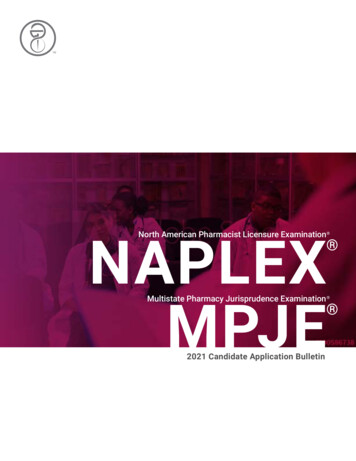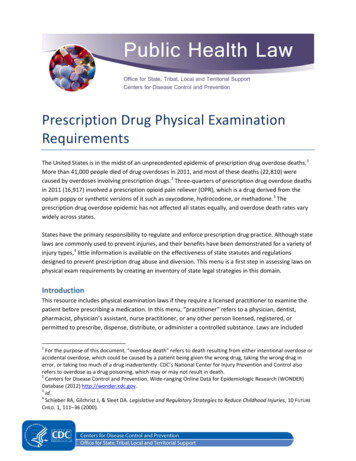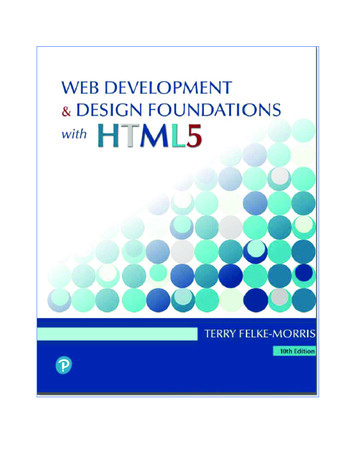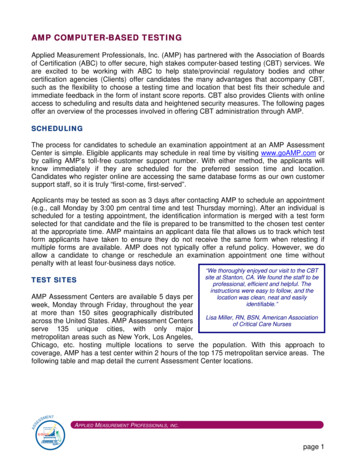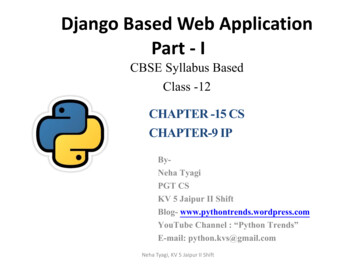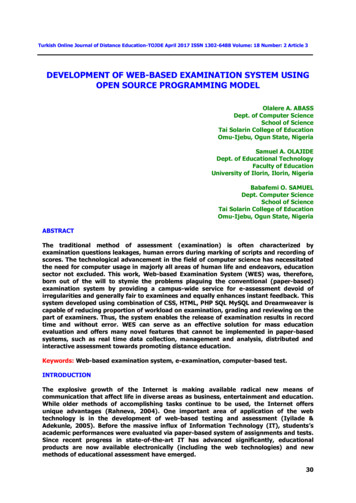
Transcription
Turkish Online Journal of Distance Education-TOJDE April 2017 ISSN 1302-6488 Volume: 18 Number: 2 Article 3DEVELOPMENT OF WEB-BASED EXAMINATION SYSTEM USINGOPEN SOURCE PROGRAMMING MODELOlalere A. ABASSDept. of Computer ScienceSchool of ScienceTai Solarin College of EducationOmu-Ijebu, Ogun State, NigeriaSamuel A. OLAJIDEDept. of Educational TechnologyFaculty of EducationUniversity of Ilorin, Ilorin, NigeriaBabafemi O. SAMUELDept. Computer ScienceSchool of ScienceTai Solarin College of EducationOmu-Ijebu, Ogun State, NigeriaABSTRACTThe traditional method of assessment (examination) is often characterized byexamination questions leakages, human errors during marking of scripts and recording ofscores. The technological advancement in the field of computer science has necessitatedthe need for computer usage in majorly all areas of human life and endeavors, educationsector not excluded. This work, Web-based Examination System (WES) was, therefore,born out of the will to stymie the problems plaguing the conventional (paper-based)examination system by providing a campus-wide service for e-assessment devoid ofirregularities and generally fair to examinees and equally enhances instant feedback. Thissystem developed using combination of CSS, HTML, PHP SQL MySQL and Dreamweaver iscapable of reducing proportion of workload on examination, grading and reviewing on thepart of examiners. Thus, the system enables the release of examination results in recordtime and without error. WES can serve as an effective solution for mass educationevaluation and offers many novel features that cannot be implemented in paper-basedsystems, such as real time data collection, management and analysis, distributed andinteractive assessment towards promoting distance education.Keywords: Web-based examination system, e-examination, computer-based test.INTRODUCTIONThe explosive growth of the Internet is making available radical new means ofcommunication that affect life in diverse areas as business, entertainment and education.While older methods of accomplishing tasks continue to be used, the Internet offersunique advantages (Rahneva, 2004). One important area of application of the webtechnology is in the development of web-based testing and assessment (Iyilade &Adekunle, 2005). Before the massive influx of Information Technology (IT), students’sacademic performances were evaluated via paper-based system of assignments and tests.Since recent progress in state-of-the-art IT has advanced significantly, educationalproducts are now available electronically (including the web technologies) and newmethods of educational assessment have emerged.30
The World Wide Web (WWW) has gained popularity within educational sector andbecome an inexpensive, easily accessible way to communicate, disseminate information,teach and examine courses and conduct researches. Consequently, there exists widepreference and adoption of web-based testing and assessment over the traditional paperbased method of assessment which has over decades been characterized by examinationquestions leakages, human errors during the marking and recording of scores. Web-basedtesting and assessment systems offer greater flexibility than the traditional approachbecause test could be offered at different times by students and in different locations(Akanbi & Adetunji, 2012). e-Examination system rides on the huge success ofInformation and Communication Technology (ICT) and its various features, security,reliability and consistency. The system simplifies the examination process by computeraided control and automatic marking to reduce the complex paper work (Meng & Lu,2011).In this current adoption of ICT towards promoting distance education where distancebetween leaners and instructors is no longer a barrier, Web-based Examination System(WES) is an effective solution for mass education evaluation. The system is based on aBrowser/Server framework which carries out the examination and auto-grading forobjective questions. The system facilitates conducting examinations, collection ofanswers, auto marking the submissions and production of reports for the test. It will beused via Internet and is therefore suitable for both local and remote examination.The system developed reduces the large proportion of workload on examination, gradingand reviewing. It also has the potentials to reduce drastically examination malpractice asexaminees are duly authenticated online in a real-time manner and their results arereleased some few minutes after the completion of the examination because where thelecturer would spend weeks marking scripts and grading manually, the computer wouldgrade the students as soon as they finish their paper, get their already stored continuousassessment and produce their eventual result. It also enhances effective distanceeducation as examinees can write examination in any part of the world and equally gettheir results instantly.The remaining parts of the paper is organized as follows. Section 2 reviewed the relatedliteratures. In Section 3, methodology and system design techniques are highlighted. TheSection 4 focuses on the implementation of the design while Section 5 presents theconclusion and recommendations.REVIEW OF RELATED LITERATURETraditional versus Electronic TestsIn educational institutions, tests are conducted to evaluate the academic progress oflearners; review, compare and measure the effectiveness of methods of instruction; serveas basis of guidance and counselling to students, selection for prize award andemployment and grading for the purpose of certification.In the context of education system, one possible purpose of a test is to assess whether alearner has attained an educational goal. The outcome of such a test can help instructorsanalyze problems with his method(s) of instruction and to better understand the learner’sstrengths and weaknesses in a given subject. Test can be used to fine-tune theinstruction environment or method based on the analytical results to improve theinstructor’s teaching performance (Chen, et. al., 2005). There are currently two methodsfor conducting tests: (i) The traditional method of using paper and pencil tests, includingthe creation of test items, the grading of students’ test sheets, and the analysis oflearner’s responses for each test item, which is considered to be tedious; and (ii)Computer-Based Tests, an electronic examination, allows test activities to be carried outusing different electronic platform/environment. Basically, the electronic examination (eExamination) system involves the conduction of examinations using various electronic31
devices (mobile phones, computers etc) connected to the testing system via the Internetor the Intranet. The process is predominantly automated, which means theadministration, grading, reviewing of the examination is of little effort. Usually theexamination is in form of multiple-choice test.Ayo, et. al. (2007) defines e-examination as a system that involves the conduct ofexaminations through the web or the intranet. They proposed a model for e-Examinationin Nigeria where all applicants are subjected to online entrance examination as a way ofcurbing the irregularities as proposed by the Joint Admissions Matriculation Board(JAMB), a body saddled with the responsibility of conducting entrance examinations intoall the Nigerian universities. This model was designed and tested in Covenant University,one of the private universities in Nigeria. Their findings revealed that the system has thepotentials to eliminate some of the problems that are associated with the traditionalmethods of examination such as impersonation and other forms of examinationmalpractices.Gardner, et. al. (2002) in their work developed a computer-supported learning system,named CECIL, which included an interesting function of ‘self-Assessment’ to enhancestudents’ learning effectiveness. The function of ‘self-assessment’ is equipped with itempools and teachers can administer and construct examinations easily through theInternet. They also pointed out that the advantages of item pools are that ‘teachers areable to incorporate large item banks (item pools) from textbook publishers and batch loadthese questions with a minimum of manual effort’. Moreover, Gardner et al. (2002) alsostated that teachers who administer and construct an examination through the Internethave the advantage of helping students to check their understanding of the learningmaterials at all hours.Wang et al. (2004) in their work developed an assessment system using Triple-A Model(assembling, administering, and appraising) as the baseline qualification in order toprovide the most comprehensive form of Computer-Based Test (CBT) or Web-Based Test(WBT) and to be more suitable for teacher education. The Triple-A Model includes theessential functions of CBT system. Assembling deals with the construction of item pools,test items, and schedules of tests. Administering is to assign the test items and itemchoices randomly, provide examination passwords for testees to apply the test throughWeb as well as collecting and recording the scores data of the tests. Appraising focuseson analyzing the collected/processed data of tests and to generate the statistic report.Zhenming, et. al. (2003) proposed a web-based operational skills examination andevaluation system for computer courses. In another research work by Rashad, et. al(2010), a web-based online examination system was proposed. The system carries outthe examination and auto-grading for student’s examinations. The system facilitatesconducting examinations, collection of answers, auto marking the submissions andproduction of reports for the test. It supports many kinds of questions. It was used viaInternet and is invariably suitable for both local and remote examination. The systemcould help lecturers, instructors, teachers and others who are willing to create newexaminations or edit existing ones as well as students participating in the examinations.The system was built using various open source technologies. AJAX, PHP, HTML andMYSQL database are used in this system. An auto-grading module was generalized toenable different examination and question types. The system was tested in the MansouraUniversity Quality Assurance Centre. The test proved the validity of using this kind of webbased systems for evaluating students in the institutions with high rate of students.32
e-Examination (Computer-Based Examination)In many tertiary institutions in Nigeria, the conduct of examinations as well as theprocess of producing results has been fraught with various problems leading to inabilityto release results on time, inability of some students to get their results and severalincomplete results. These problems can be mitigated using electronic medium.E-examination, as used in this paper, refers to a system that involves the conduct ofexaminations through the web or the intranet using the computer system. Recently,because Internet and database technology have been fully developed, CBT which beforewas once hosted only on personal computers (PCs) or local area networks (LANs), hasnow gradually been upgraded to work on the Internet using browsers as the testinterface so that users can use it anywhere in the world. WES has been seen to be aneffective solution for mass education evaluation (Zhenming etal, 2003).Computer-based examination and test tools have been applied for different purposes, e.g.placement tests, entry-level tests (prognostic tests), self-assessment tests, regularwritten and oral examinations (selective and diagnostic examinations), and onlinesurveys.METHODOLOGY AND SYSTEM DESIGNThis technical paper intends to showcase the development of e-examination applicationtowards enhancing effective distance education where digital divide is eliminated inaccess to qualitative education across the globe.The application was developed using different programming models and languages whichinclude HTML, CSS and PHP (for the front-end interface) and MYSQL (for the backend)and served through a web server, APACHE. The use of HTML and CSS, which is a markuplanguage for information presentation and a styling language respectively, allow for theuser-interface to be designed and properly laid out. To enable dynamic contentgeneration, PHP (a web scripting language) is used to generate dynamic contents basedon the user of the system and the corresponding content stored in the backend databasewhich is managed by MySQL. The web server is used to serve the webpages to userswhen they are needed, and also to interpret the PHP scripting commands contain in thepage. In other words, the computer simply acts as the medium for students to takeexaminations, for teachers to construct tests, and for the transmission of test papers.Web-based Examination System PhasesThis WES has three phases. Namely: (i) The presentation phase offers an interface to theuser. (ii) The business/logic phase serves as the middleware that is responsible forprocessing the user’s requests. (iii) The database phase or question bank serves as therepository of a pool of questions to be answered by the student.DEVELOPMENT LANGUAGESCascading Style Sheet (CSS)It is a set of rules that allow user to control how the web document will appear in the webbrowser. It defines the formatting applied to a Website, including colors, backgroundimages, typefaces (fonts), margins, and indentation. The basic purpose of CSS is to allowthe designer to define a style (a list of formatting details such as fonts, sizes, and colors)and then, to apply it to one or more portions of HTML pages using a selector. CSSinformation can be specified in three different places: (i) within the specific tags in thedocument body (Inline CSS), (ii) at the top of the document within a style block, orcombined with named div or span containers in the document body (EmbeddedCSS), and (iii) in one or more separate files shared across many Web pages (External CSS)33
Hyper Text Mark-up Language (HTML)It is the core technology in which all Web pages are written. HTML is not a programminglanguage rather it is a mark-up language for collection of mark-up tags to describe Webpages. Mark-up is made up of tags, and tag names are enclosed in angle brackets.Hypertext Pre-processor (PHP)It is a widely-used Open Source general-purpose scripting language that is specificallysuited for Web development and can be embedded into HTML. Unlike other CGI scriptwritten in other languages like Perl or C, where lots of commands are written to outputHTML, the PHP code is enclosed in special start and end tags that allow you to jump intoand out of PHP mode. What distinguishes PHP from something like client-side JavaScriptis that the code is executed on the server?Structured Query Language (SQL)This is the standard language designed to access relational databases.3.3INTEGRATED DEVELOPMENT ENVIRONMENTFigure 1: Architecture of the systemTo make software development easier and faster, Integrated Development Environment(IDE) may be adopted. An IDE is a software application that provides comprehensivefacilities to computer programmers for software development. An IDE normally consist ofa source code editor; build automation tools and a debugger (Burd, 2005).MySQL WorkbenchMySQL is the world’s most popular open source database, enabling cost effective deliveryof reliable, high-performance and scalable web-based and embedded databaseapplication. The data in MySQL are stored in tables.MySQL workbench is a unified visual tool for database architectures, developers, andDBAs. It provides data modeling, SQL development and comprehensive administrationtools for server configuration, user administration, backup and much more. MySQLworkbench enables a DBA, developer, or data architect to manage databases. It includeseverything a data modeler needs for creating complex Entity Relational (ER) models,forward and reverse engineering and also delivers key features for performing difficultchange management and documentation tasks that normally require much time andeffort. MySQL workbench delivers visual tools for creating, executing and optimizing SQLqueries. The SQL editor provides color syntax highlighting, auto-complete, reuse of SQLsnippets and execution history of SQL. The database connections panel enables34
developers to easily manage database connections. The object browser provides instantaccess to database schema and objects.Dreamweaver CS5Dreamweaver is a web design and development application that provides a visualWYSIWYG editor (colloquially referred to as the design view) and a code editor withstandard features such as syntax highlighting, code completion and code collapsing aswell as more sophisticated features such as real-time syntax checking and codeintrospect for generating code hints to assist the user in writing code. The design viewfacilitates rapid layout design and code generation as it allows users to quickly create andmanipulate the layout of HTML elements. It also features an integrated browser forpreviewing developed webpages in the program’s own preview pane in addition toallowing content to be open in locally installed web browsers. Dreamweaver providestransfer and synchronization features, the ability to find and replace lines of text or codeby search terms or regular expressions across the entire site, and a templating featurethat allows single-source update of shared code and layout across entire sites withoutserver-side includes or scripting. Dreamweaver like other HTML editors, edit files locallythen uploads them to the remote web server using FTP, SFTP or WebDAV.SYSTEM DESIGNDatabase (Backend) DesignDatabase design is concerned with how data is represented and stored within the system.The examination questions, answers, grades, and reviews must be stored in a persistentway. Moreover, we need to keep information about the students. The system stores theabove information in a MySQL Database server. Such database has been chosen since it isopen source, and there are implementations available for the main architecturesUser Interface (Frontend) DesignUsability is the ease with which a user can learn to operate, prepare inputs for, andinterpret outputs of system or component. This usability of a system is made less more orless stressful by the usability and complexity of the user interface. The user interface of asystem is therefore the part of the system that the end user interacts with. User interfacedesign is concerned with how users add information to the system and with how thesystem presents information back to them.BootstrapBootstrap is a collection of tools for creating websites and web applications. It containsHTML and CSS-based design templates for typography, forms, buttons, navigation andother interface components as well as optional JavaScript extensions. Bootstrap wasdeveloped at Twitter as a framework to encourage consistency across internal tools.Bootstrap is compatible with all major browsers and it also supports responsive designi.e. the layout of web pages adjusts dynamically, taking into account the characteristicsof the device used (PC, tablet, mobile phone). Bootstrap works by proving a clean anduniform solution to the most common, everyday interface tasks developers come across.It is flexible enough to work for many unique design needs.SYSTEM REQUIREMENTS AND SPECIFICATIONSFunctional RequirementsFunctional requirement defines the capabilities and functions that a system must be ableto perform successfully. In software engineering and system engineering a functionalrequirement defines a function of a system or its component. These functions are the setof inputs, the behavior and outputs of the system in question. In order words it capturesthe intended behavior of the system. This behavior may be expressed as services, tasks orfunctions the system is required to perform and it shows the features that differentiatethe system from other systems. Functional requirements should include: Descriptions ofdata to be entered into the system, descriptions of operations performed by each screen,35
descriptions of work-flows performed by the system, which can enter the data into thesystem and how the system meets applicable regulatory requirementsThe intended software’s functions are highlighted below: The system has a homepage where respective users (administrator & students)can login to perform their different operations. The system has the test page where the student would be presented with testquestions to be answered by him/her. The system then automatically adds themarks allocated in each question to determine the total mark for the test.Non-functional RequirementsThese define system properties and constraints e.g. reliability, response time and storagerequirements. Constraints are I/O device capability, system representations, etc. It is arequirement that specifies criteria that can be used to judge the operation of a system,rather than specific behaviors. This should be contrasted with functional requirementsthat define specific behavior or function.SYSTEM IMPLEMENTATIONTo test the effectiveness of the design, PHP and HTML were used, with MySQL as theback-end integration database. The choice of these programming languages is based onthe features of the languages that make them very appropriate for this work.System Requirement and SpecificationThe minimum hardware and software requirements for the WES are: Minimum of PentiumIV or IBM compatible system, 500Mhz processor speed or higher, minimum of 512MBmemory capacity, minimum of Windows XP as the operating system (OS), support anyweb browser. Internet Explorer, Mozilla Firefox, Google Chrome and Xamp server.InterfacesLogin/register pageFigure 2. Log-in PageLogin module helps the user (students or lecturers) to login to the site. The lecturercannot login on this platform but would be done by the administrator. An administrator isto register the lecturers’ credential and then provide each lecturer with login credentials.The students must register first before using the registered credentials to login. The loginprovision in this page helps the already registered user to directly access the site. On thepage spaces have been provided for the user (students) to enter their respectiveusername and password.36
Figure 3. Register PageLecturer’s examination creation pageThis platform enables the lecturer to set examination mode before proceeding to set thequestions. Here, course name and code will be specified by the lecturer including theallocated time and date of the examination.Figure 4. Examination Setup PageQuestion, examination and result pagesAfter setting up the examination, the lecturer will proceed in setting up the questions forthe examination. This platform will provide the avenue for questions setup and correctanswer to each question will be marked by the lecturer.37
Figure 5: Question Creation PageFigure 5. Question CreationPageFigure 6. Examination PageFigure 7. Examination Completion Page38
Figure 8. Result PageBackend/Database DesignFigure 9. Database View PageDatabase design is the process of producing a detailed data model of a database. Thislogical data model contains all the needed logical and physical design choices andphysical storage parameters needed to generate a design in a Data Definition Language,which can then be used to create a database. The database of the system is presentedbelow. The database has eight tables (admin, courses, option, question, registration,results, student, and tests) in it. The option table holds the various options to thequestions to be presented to the students, the results table holds the various scores ofthe students that partook in the test, the question table holds the questions that wouldbe presented to the students, while the students table holds the students’ information.CONCLUSION AND RECOMMENDATIONSIt is not enough to focus on the passing required skills to the learners in distanceeducation but to equally furnish them with their performances shortly after evaluationwithout hitch. Consequently, the developed WES is capable of solving the associatedproblems with the traditional test methods and equally promotes distance education.39
When online method of instruction is used to acquire skills in higher education, theapplication can be used for efficient assessments regardless of the location of theexaminees across the globe.It is possible with this system to space the period of examination without compromisingquality and integrity of the examination. The system has the potentials to reducedrastically examination malpractice as applicants are duly authenticated online, real-timebefore taking the examination and the integrity of the result could also be enhanced sincethe candidates have access to instant result checking.Hence, in the current era of distance education prompted by the adoption of ICT, the eExamination has the advantage of being easy to administer, ability to offer applicantsinstant results, easy verification, devoid of paper work and long-time involved in markingexamination scripts which in most cases are prone to errors and misplacement of somescripts due to the large volume of scripts that has to be marked and accessed. The systemalso saves the instructors from sufferings and boring grading of works as well asexaminees’ access to results thereby promoting efficient distance education system.If the e-examination system is fully optimized and it is introduced into the institutions, itwill go a long way to control and check examination malpractices and all fraudulent actsassociated with the manual process of writing examination. However, for the system tobe adopted on a large scale, efforts should be intensified to ascertain its disadvantage onaccounts of IT illiteracy on the part of the students’, by making the interface easy tointeract with. Also, to ensure that the e-examination system is not intensified by thosethat may want to engage in any form of examination malpractice, the addition of userauthenticated protocol/methods such as biometrics (fingerprint, retina, iris etc)identification will be of good help.In future, we intend to address the limitations of the current application by incorporatingonline collation of results from various courses examined, compute Cumulative GradePoint Aggregate (CGPA) and generation of transcripts (with necessary security features)to foster implementation of distance education.BIODATA and CONTACT ADDRESSES of AUTHORSOlalere A. ABASS is a lecturer in the Department of ComputerScience, School of Science, Tai Solarin College of Education, OmuIjebu, Ogun State, Nigeria. He obtained M.Sc. Computer Sciencefrom University of Ibadan, Nigeria in 2012 and currently a Ph.D.student in the Department of Computer Science, Federal Universityof Agriculture, Abeokuta, Nigeria. His academic interest areas areinformation systems, database management, web applicationdevelopment and e-learning implementation. He has over 13-yearexperience in research and teaching with 14 publications in bothnational and international journals.Olalere A. ABASSDepartment of Computer Science,Tai Solarin College of Education, Omu-Ijebu, 120103, Ogun State, Nigeria.Phone: 234-818-167-5151,E-mail: olaabas@gmail.com40
Samuel A. OLAJIDE studied Computer Science/Mathematics in theDepartment of Computer Science, School of Science, Tai SolarinCollege of Education, Omu-Ijebu, Ogun State, Nigeria. He obtainedhis National Certificate in Education in 2015 from this institution. Heis currently a research student in Computer Science with Educationin the Department of Educational Technology, Faculty of Education,University of Ilorin, Nigeria. His academic interest area is webapplication development.Samuel A. OLAJIDEDepartment of Educational Technology (Computer Science Option),University of Ilorin, Ilorin, 240003, Nigeria.Phone: 234-706-235-2644E-mail: samolatec@gmail.comBabafemi O. SAMUEL is a lecturer in the Department of ComputerScience, School of Science, Tai Solarin College of Education, OmuIjebu, Ogun State, Nigeria. He obtained B.Sc.(Ed.) Computer Sciencefrom Tai Solarin University of Education, Ijagun, Nigeria. He iscurrently a postgraduate student of Computer Science in NationalOpen University of Nigeria, Abuja, Nigeria. He has 5 years ofteaching and research. His academic interest areas web applicationprogramming and database administration. He has both national andinternational journals to his credit.Babafemi O. SAMUELDepartment of Computer Science,Tai Solarin College of Education, Omu-Ijebu, 120103, Ogun State, Nigeria.Phone: 234-806-534-9798E-mail: princefm@live.comREFERENCESAkanbi, C.O., & Adetunji, A.B (2012). An Online Essay-Based ExaminationAssessmentModel Using Double Blind Marking Tecnique. African Journal of Computing andICT, 5(6), 104-108.Ayo, C., Akinyemi, I., Adebiyi, A., & Ekong, U. (2007). The Prospects of E-Examination.Turkish Online Journal of Distance Education-TOJDE, 8(4), 125-134Burd, B. (2005). Beginning Programming with Java for Dummies, 2nd ed. Indianapolis,Indiana: Wiley Publishing, Inc.Indianapolis, Indiana.Chen, D.J., Lai, A.F., & Liu, I.C. (2005). The Design and Implementation of a DiagnosticTest. Journal of Information Science and Engineering, 21, 1007-1030.Gardner, L., Sheridan, D., & White, D. (2002). A Web-based learning and assessmentsystem to support flexible education. Journal of Computer Assisted Learning, 18,125–136.Iyilade, J. S., & Odekunle, W. O. (2005). A Web-based Student Testing and AssessmentSystem. Teaching, Research and Administration, AICTTRA, 1, 16-24.41
Olga D. R. (2004). Multilingual Graphical Authoring Editor in a Distributed e-TestingCluster. Proceeding of Electronics’ 2004, Sozopol, Bulgaria.Rashad, M. Z., Mahmoud S, K., Ahmed E, H., & Mahmoud A, Z. (2010). An Arabic WebBased Examination. International Journal of Electrical &
generation, PHP (a web scripting language) is used to generate dynamic contents based on the user of the system and the corresponding content stored in the backend database which is managed by MySQL. The web server is used to serve the webpages to users when they are needed, and also to interpret the
